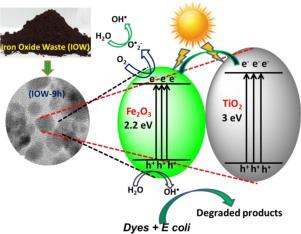Journal of Environmental Chemical Engineering ( IF 7.4 ) Pub Date : 2020-07-28 , DOI: 10.1016/j.jece.2020.104297 Purna K. Boruah , Archana Yadav , Manash R. Das

|
The development of waste-derived heterogeneous catalysts can offer substantial savings in manufacturing costs and reduces disposal costs. Herein, we have developed waste iron oxide nanopowder having 7.6 wt.% of titanium dioxide (IOW-9 h) from industrial waste materials adopting a simple cost-effective planetary wet ball milling technique. Most prominently, the IOW-9 h nanopowder was obtained without using any chemical treatment with an average size distribution of ∼10 nm. IOW-9 h was characterized by several sophisticated analytical instruments like powder X-ray diffractogram (XRD), X-ray photoelectron spectrometer (XPS), high-resolution transmission electron microscope (HRTEM), field emission scanning electron microscope (FESEM), vibrating sample magnetometer (VSM), Raman spectroscopy, Fourier transform infrared (FT-IR), fluorescence spectrophotometer and zeta potential analyzer. IOW-9 h nanopowder was utilized towards the photocatalytic degradation of model dye molecules, inactivation of bacteria cells and decolorization of tannery wastewater under sunlight irradiation. The formation of degradation intermediates for dye molecules was also studied by HR-MS analysis at different time intervals. IOW-9 h nanopowder showed a better recyclable capability of 78 % upto 10 cycles through photocatalytic dye degradation. Further, we characterized the IOW-9 h nanopowder after use in the photocatalytic degradation process. There are no significant changes in morphology after the use of the IOW-9 h nanopowder as a photocatalyst.
中文翻译:

源自工业废料的磁性混合金属氧化物纳米材料及其在环境修复中的光催化应用
废物衍生的非均相催化剂的开发可以大大节省制造成本并降低处理成本。本文中,我们采用简单的经济高效的行星式湿式球磨技术,从工业废料中开发了具有7.6 wt。%二氧化钛(IOW-9 h)的废氧化铁纳米粉。最显着的是,无需任何化学处理即可获得IOW-9 h纳米粉,平均粒径分布约为10 nm。IOW-9 h的特点是采用了几种复杂的分析仪器,例如粉末X射线衍射图(XRD),X射线光电子能谱仪(XPS),高分辨率透射电子显微镜(HRTEM),场发射扫描电子显微镜(FESEM),振动样品磁力计(VSM),拉曼光谱,傅立叶变换红外(FT-IR),荧光分光光度计和Zeta电位分析仪。IOW-9 h纳米粉被用于模型染料分子的光催化降解,细菌细胞的失活和日光照射下制革废水的脱色。还通过不同时间间隔的HR-MS分析研究了染料分子降解中间体的形成。IOW-9 h纳米粉通过光催化染料降解显示出高达10个循环的78%更好的可回收能力。此外,我们表征了用于光催化降解过程中的IOW-9 h纳米粉。使用IOW-9 h纳米粉作为光催化剂后,形态没有明显变化。阳光照射下细菌细胞的失活和制革废水的脱色。还通过不同时间间隔的HR-MS分析研究了染料分子降解中间体的形成。IOW-9 h纳米粉通过光催化染料降解显示出高达10个循环的78%更好的可回收能力。此外,我们表征了用于光催化降解过程中的IOW-9 h纳米粉。使用IOW-9 h纳米粉作为光催化剂后,形态没有明显变化。阳光照射下细菌细胞的失活和制革废水的脱色。还通过不同时间间隔的HR-MS分析研究了染料分子降解中间体的形成。IOW-9 h纳米粉通过光催化染料降解显示出高达10个循环的78%更好的可回收能力。此外,我们表征了用于光催化降解过程中的IOW-9 h纳米粉。使用IOW-9 h纳米粉作为光催化剂后,形态没有明显变化。IOW-9 h纳米粉通过光催化染料降解显示出高达10个循环的78%更好的可回收能力。此外,我们表征了用于光催化降解过程中的IOW-9 h纳米粉。使用IOW-9 h纳米粉作为光催化剂后,形态没有明显变化。IOW-9 h纳米粉通过光催化染料降解显示出高达10个循环的78%更好的可回收能力。此外,我们表征了用于光催化降解过程中的IOW-9 h纳米粉。使用IOW-9 h纳米粉作为光催化剂后,形态没有明显变化。











































 京公网安备 11010802027423号
京公网安备 11010802027423号